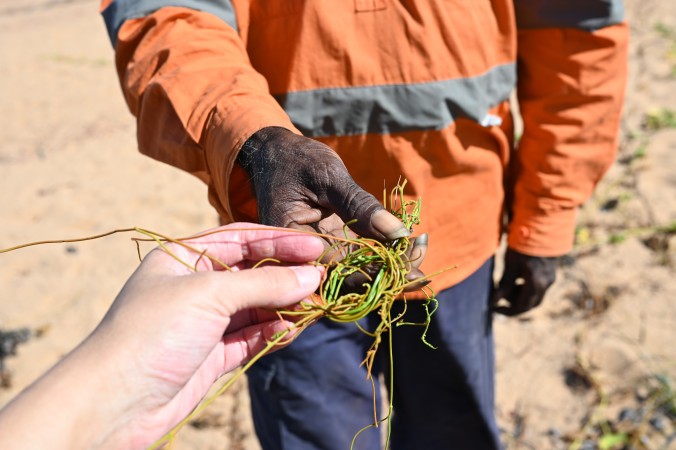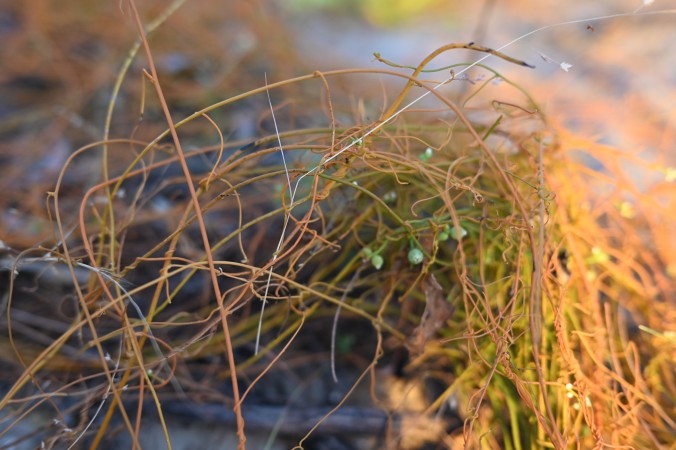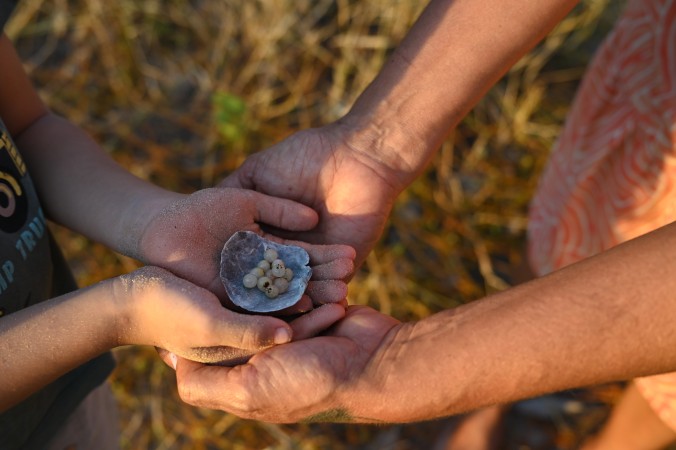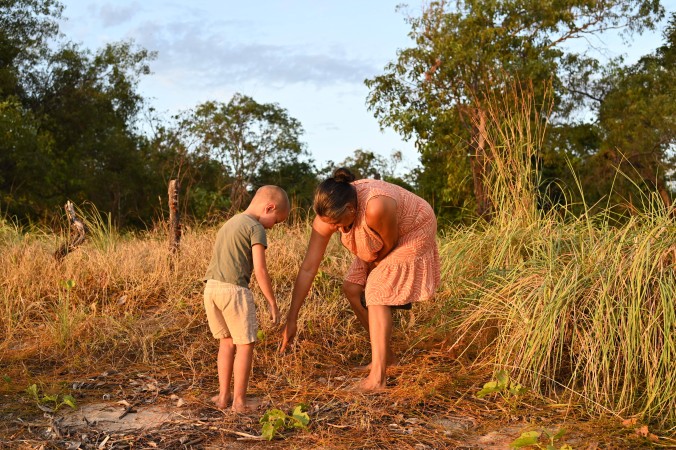Nature’s Kin: The Integral Role of Kinship in Indigenous Medicine
By Sheridan Teitzel - 2024 Monica Clare Research Fellow | 24 June 2024
Guest blogger: Sheridan Teitzel - 2024 Monica Clare Research Fellow.
Project: Sacred plants and cultural frameworks: Capturing first nations value systems in western Cape York.
Cultural contributors: Richard Barkley (Napranum Elder, Thainakwith), Marie Kalkiyorta (Songwoman, Wik-Puutch), Dorothy Pootchemunka (Senior Aurukun Elder, Winchanum/Aplach), Constance Bandicootcha (Puutch Elder), Fiona Wirrer-George (Alngith-Layngnith, Mbaiwum), Lyall Kawangka (Chairperson, Ngan Aak Kunch), Richard Ornyengaia (Wik-Way/Wanam).
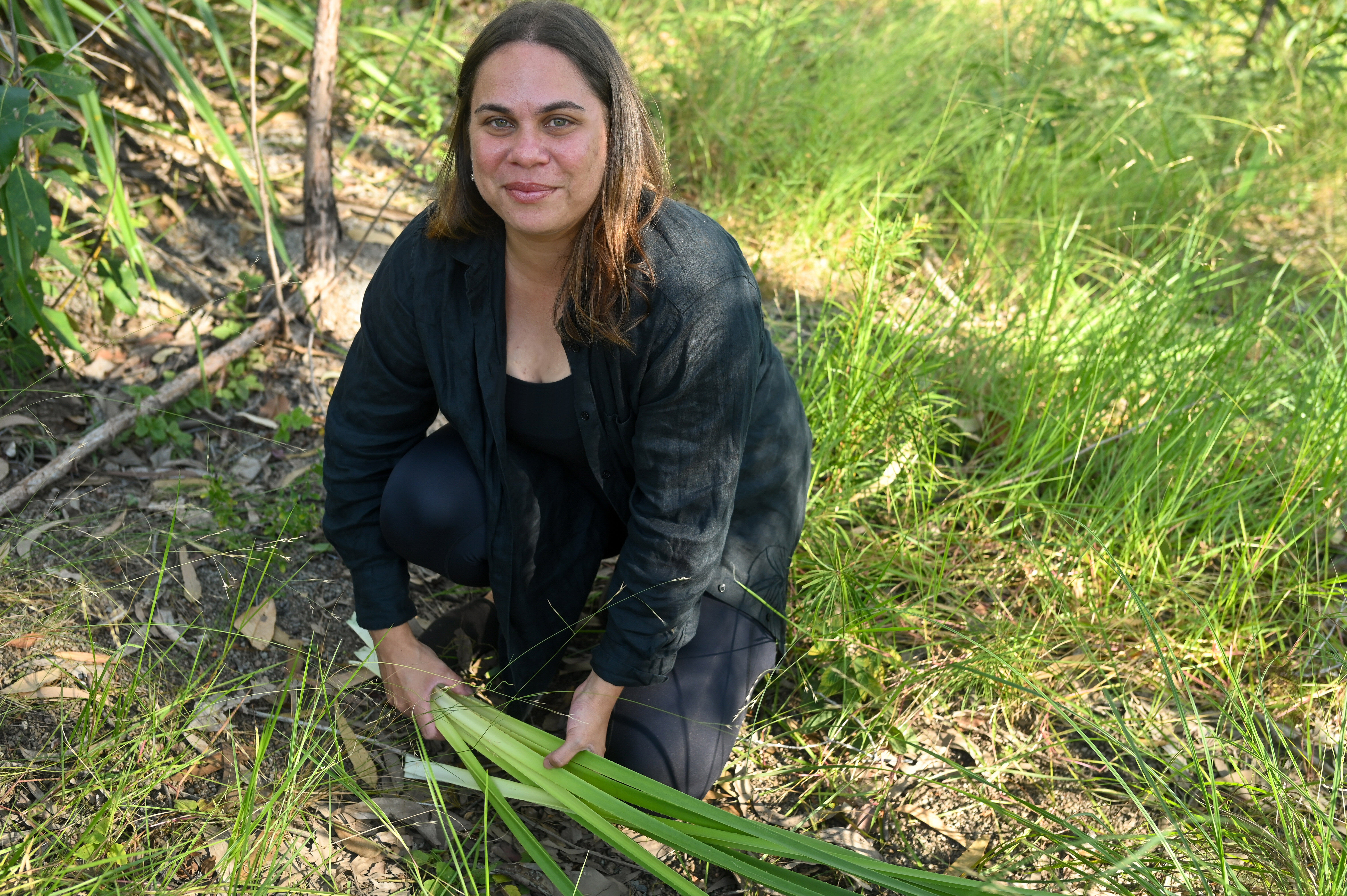
Sheridan holding pandanus leaves which have been harvested to strip and prepare for weaving.
You see that tree, that rock, that animal? That’s me. You don’t go there; you don’t disturb this place – without me”.
Well of course, I think as I sit under the paper bark tree, listening to my Kukoo (big uncle) Richard Barkley who is a highly knowledgeable and skilled Napranum elder. You wouldn’t go into someone’s home, disturb their place, cause destruction, and take without asking. While this concept is not foreign or hard to understand, its application is seemingly quite complex when it comes to Indigenous matters. This disconnect, it seems, stems from deeply rooted notions and understanding of ownership, guardianship, responsibility, duty, and one’s place in nature and the cycle of life.
To the Indigenous peoples of Western Cape York, ownership was more than just possessing something, it was an all-encompassing duty whereby the land one is born to, becomes an extension of oneself, and to harm the land is to harm the people, and to harm the people is to harm the land. This approach to life seems to have developed out of survival in the harsh landscape of Cape York. For Indigenous people, survival depended largely on instinct, and, in many ways, intuition can be thought of as amplified instinct. This perspective can be observed in several initiation practices, where individuals are placed in situations that force them to enhance and refine their intuition. By fully connecting to their instincts to refine their intuition, they must navigate these challenges, as failure to do so could, and sometimes did, result in death. It is this very intuition that has enabled Indigenous people to connect with their environment to such a degree that the separation between individuals and their environment starts to blur. Understanding this concept is key to understanding Indigenous systems of plant medicine. Even more so, grasping this concept is paramount to understanding the impacts of colonisation to many Indigenous peoples around Australia.
At its core, Indigenous notions of health and medicine centre around balance, both within and outside of the human being. This can be observed in the wisdom and knowledge shared with me throughout this project. It has been a great blessing to be able to work with my Kukoo, Richard Barkley of the Thainakwith clan, and my uncle, Richard Ornyengaia who is a Liningtihi/Wik man. Phase one of the project sought to gain insights into the foundational principles underlying Indigenous frameworks of plant medicine, as opposed to the medical constituents of native plants. The concept of plants as aids as opposed to resources is not foreign, but what is poorly understood is the depth by which plants are integrated into the Indigenous kinship system, and how this system acts as both a connective force and a complex and comprehensive system of recording and sharing information.
Throughout phase one, a few key insights have become increasingly clear, however, so has the vastness of this area of study. It is important to understand that whilst Indigenous healing and medicinal practices are primarily a lifestyle, there is a point at which approaches to healing become a practice. Throughout phase one, a clear and practical framework has started to form consisting of several key components including categories, therapies, kinship relationships, and diagnostic processes. At this point in the project, five categories of traditional medicine have been identified including lifestyle, functional, crisis, general, and spiritual. These categories include a range of natural resources including plants, animal and insect derivatives, elements, and ceremonial practices. Diagnostic approaches appear to be made within these categories and follow clear processes that include assessments of the human, their ailments, the relevant kinship connections, and their environment including factors such as spiritual influences, weather conditions, and seasonal availability. Unlike other traditional herbal practices, Indigenous people from the Western Cape York had an extremely limited use with what was considered to be “dead” or dried plants, instead working almost exclusively with “live” plants. This approach is largely influenced by the reciprocal nature by which Indigenous people worked with plants and the broader considerations given throughout the diagnostic process. As many healing aids are considered family and integrated into the kinship system, Indigenous peoples had a “marriage” or “familial” relationship with their land and surroundings. This relationship demonstrated a reciprocal nature of access, use, responsibility, and duty that the English term “ownership” is incapable of fully conveying. In this way, one’s country and all that is within it is “owned” by a people the way a child might to be to their parent or a spouse to their other - it is more of a belonging to. To take the land from the people would be akin to taking a child from parent, deeply devastating yet not necessarily able to be conveyed by English notions of ownership. Because of this, when working with natural elements during healing, permission is sought and faith is placed in the provision of the mother, the ancestors, and the spirits of country that what was needed is accessible and provided at the required time. As such, there was little need to store dried plants and much of what was available, was often multi-functional and fit within several categories.
These practices demonstrate holistic and circular frameworks that will continue to be developed and refined throughout the course of this project and inform a visual representation of the web of healing practices, their practitioners, the kinship relationships, and the uses for up to 15 medicinal plants in the Cape York region. Additionally, the use of animal and insect derivatives and elemental forces will also be considered. It seems that contexts vary depending on the relevant category, and kinship may be used to identify the antidote in one category as opposed to a restricted use plant in another. Conversely, under certain circumstances, totemic relationships are drawn upon as aids but are to be entirely avoided under other circumstances. While further research is required, these findings highlight the unique ways in which information is stored, retrieved, and practiced within the relevant cultural frameworks.
Many of these practices are still commonplace today, with Indigenous peoples in Western Cape York continuing to engage in hunting, cleansing, birth and death ceremonies, and plant medicine practices. Understanding and integrating Indigenous knowledge systems into contemporary frameworks not only honours the cultural heritage of this country but it also offers pathways to meaningful reconciliation and valuable insights that can improve the wellbeing of people from all walks of life.
Sheridan Tietzel
www.arnya.com.au
The Monica Clare Research Fellowship is generously supported by The Siganto Foundation.
Read other blogs by Sheridan Teitzel
- Guided by Lore: The role of Kinship and Totemic Dreaming in Indigenous Systems of Healing
- Then vs Now: The Changing Landscape of Indigenous Healing
Read more blogs about Queensland's First Nations history by past Monica Clare Research Fellows.
Sacred Plants & Cultural Frameworks: Project Trailer - Phase One.
Follow us as we explore the intricate systems of Indigenous plant medicine in Western Cape York. Featuring Thainakwith elder, Richard Barkley and produced by Liningithi woman, Sheridan Teitzel, this trailer provides a snapshot to a much larger project that dives into the rich cultural heritage and traditional knowledge that has been passed down through generations, showcasing the connection between the land and its people.
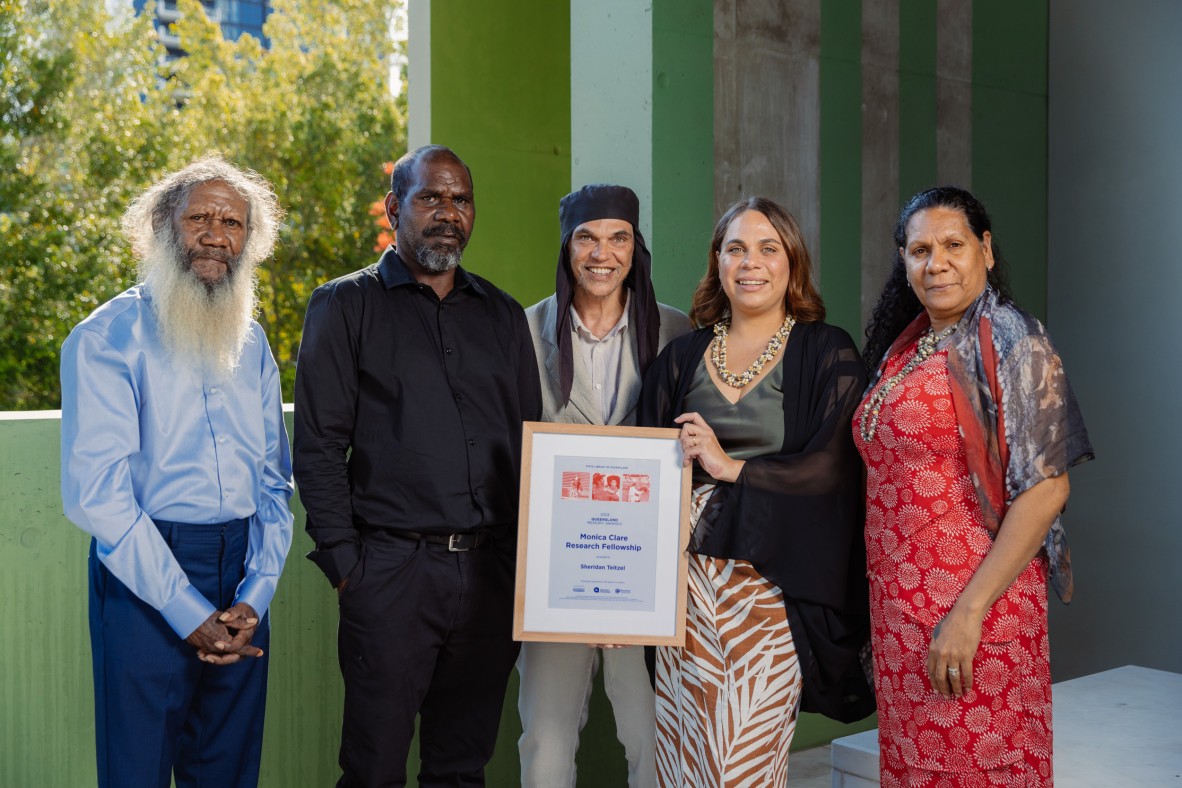
2024 Monica Clare Research Fellow, Sheridan Teitzel with family and community members.
(From the Left) Napranum Elder, Richard Barkley and senior family member, Richard Ornyengia from Aurukun. Sheridan's father, Guthula Doyle and mother Fiona Wirrer-George.
Sheridan Tetizel's Research Reveals talk.
Comments
Your email address will not be published.
We welcome relevant, respectful comments.
